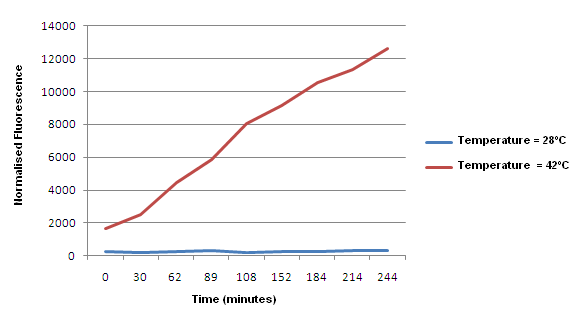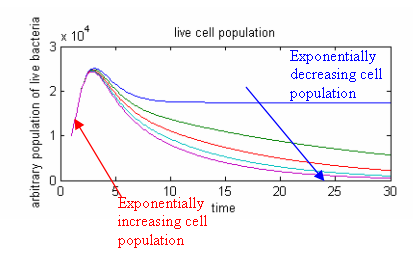Team:Imperial College London/Major results
From 2009.igem.org
(→Module 3 - Genome Deletion) |
(→Module Integration - Thermoinduction) |
||
| Line 56: | Line 56: | ||
==Module Integration - Thermoinduction== | ==Module Integration - Thermoinduction== | ||
| - | + | To investigate the behaviour of the lamda-cI thermoinducible promoter and show that when temperature is low (at 28 degrees Celsius), there is low fluorescence output. This shows that the genome deletion module is repressed. | |
| + | When temperature is raised to 42 degrees Celsius, fluorescence increases, indicating that the repression is lifted. | ||
| + | We are looking at both absorbance and fluorescence data. This analysis serves to characterize the construct [http://partsregistry.org/wiki/index.php/Part:BBa_K200022 BBa_K200022], submitted by Harvard last year. | ||
| + | |||
| + | <b>The characterization of the thermoinducible promoter is as follows: | ||
| + | * At 28 ºC, we cannot observe any fluorescence (GFP) output because its expression is repressed | ||
| + | * At 42 ºC, we can observe an increase in fluorescence (GFP) output, as its expression is no longer repressed | ||
| + | Hence, we can conclude that in the E.ncapsulator system, an increase in temperature de-represses the expression of downstream genes, which trigger the genome deletion phase. </b> | ||
| + | [[Image:II09_HVD_GFP_MAIN.png]]<br> | ||
<!--==Simulations: Chemoinduction for <b>Module 1</b>== | <!--==Simulations: Chemoinduction for <b>Module 1</b>== | ||
| Line 89: | Line 97: | ||
</html>--> | </html>--> | ||
<br> | <br> | ||
| + | |||
=References= | =References= | ||
[1]Physica A: Statistical and Theoretical Physics, Vol. 188, No. 1-3. (1 September 1992), pp. 404-425. A rigorous derivation of the chemical master Equation | [1]Physica A: Statistical and Theoretical Physics, Vol. 188, No. 1-3. (1 September 1992), pp. 404-425. A rigorous derivation of the chemical master Equation | ||
{{Imperial/09/TemplateBottom}} | {{Imperial/09/TemplateBottom}} | ||
Revision as of 21:59, 21 October 2009

Contents |
Major Results
This page contains highlights of our major results and simulations. It is by no means complete. However, more results will be presented at the jamboree.
Genome Digestion Assay
- The wet lab has also investigated the effects of restriction enzymes on cell population. Positive results were achieved.
The Dam negative strains are fully cleaved at all different concentrations of restriction enzyme. This produces the 'smear' that can be seen, as the DNA fragments are all of varying, but short lengths
From these results, we have shown that restriction enzymes can cleave Dam negative strains, hence killing Dam negative cells. This also proves Dam positive strains are protected again genomic deletion.
- Furthermore, the dry lab has provided a model on cell population under the production of restriction enzymes.
We have shown that an increase in restriction enzyme concentration will decrease total cell population, under the abscence Dam protection.
Module Integration - Autoinduction
- Experiments were performed on the CRP promoter. From this experiment, we are able to choose the best media for the optimal growth of cells.
Corrected fluorescence of glucose is almost negligible. From this, we have proved the theory that glucose represses the PcstA promoter strongly.
Also, 10% Casamino Acids in M9 shows the highest corrected fluorescence as well as a high corrected OD600, indicating good cell growth. Therefore, this is our media of choice.
diauxic growth
Module Integration - Thermoinduction
To investigate the behaviour of the lamda-cI thermoinducible promoter and show that when temperature is low (at 28 degrees Celsius), there is low fluorescence output. This shows that the genome deletion module is repressed. When temperature is raised to 42 degrees Celsius, fluorescence increases, indicating that the repression is lifted. We are looking at both absorbance and fluorescence data. This analysis serves to characterize the construct [http://partsregistry.org/wiki/index.php/Part:BBa_K200022 BBa_K200022], submitted by Harvard last year.
The characterization of the thermoinducible promoter is as follows:
- At 28 ºC, we cannot observe any fluorescence (GFP) output because its expression is repressed
- At 42 ºC, we can observe an increase in fluorescence (GFP) output, as its expression is no longer repressed
Hence, we can conclude that in the E.ncapsulator system, an increase in temperature de-represses the expression of downstream genes, which trigger the genome deletion phase.

References
[1]Physica A: Statistical and Theoretical Physics, Vol. 188, No. 1-3. (1 September 1992), pp. 404-425. A rigorous derivation of the chemical master Equation
 "
"






